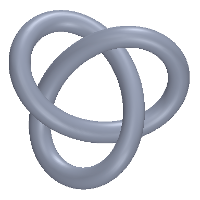
|
Margaret Doig
Assistant Professor of Mathematics, Creighton University
|
|
|
Publications and Preprints
- Graph blocks, radius and diameter, and an application to the Randić index (originally titled Randić index, radius, and diameter for cactus graphs). To be submitted. arXiv:2107.00071. An extension of graph eccentricity to blocks, with a sharper bound for the relationship between radius and diameter and a proof of a conjectured relationship between radius and Randić index for a cactus graph. (Sorry, temporarily undergoing rewrites!)
- Maximum run length in a toroidal grid graph. To be submitted. arXiv:math.CO/0412530. (2 citations in peer-reviewed publications). Bounds on the maximum run length of a graph product in terms of its components; bounds on the k-nary cube; and a partial classification of graphs with maximum run length 3. (Sorry, temporarily undergoing rewrites!)
- Typical knots: size, link component count, and writhe. To be submitted. arXiv:2004.07730. The probabilistic behavior of three link invariants under the grid diagram model.
- A combinatorial proof of the homology cobordism classification of lens spaces (with Stephan Wehrli). With a referee, New York Journal of Mathematics. arXiv.org:1505.06970. (3 citations in peer-reviewed publications). A combinatorial proof that the Heegaard Floer d-invariants detect the homeomorphism type of a lens space; as a corollary, a new proof of the integral homology cobordism classification of lens spaces.
- Essential extensions and injective hulls of fuzzy modules (with D. S. Malik). Submitted. A definition of the essential extension of a fuzzy modules, a necessary condition for a fuzzy injective hull to exist, and equivalent conditions for an extension to be a fuzzy injective hull.
- A fuzzy approach to sustainability I: A time-series analysis of the Sustainable Development Goals (with D. S. Malik). To appear, New Mathematics and Natural Computation. A new measure inspired by fuzzy math to asses world progress in sustainable development; part 1 of 2, an analysis of individual countries' progress in the 17 Goal areas using the UN's sustainable development dataset.
- A fuzzy approach to sustainability II: The 2030 Agenda for Sustainable Development (with D. S. Malik). To appear, New Mathematics and Natural Computation. Part 2 of 2, an analysis of worldwide progress towards the Goals as a whole, including the impact of income category and region.
- Condorcet in Math Class: How an Eighteenth Century Philosophe Enriches the Modern Undergraduate Experience. XVIII New Perspectives on the Eighteenth Century 20:1 (2023). An exploration of how we use voting theory in the classroom to satisfy teaching objectives in logic and in teaching applications of mathematics, as well as how Nicolas de Condorcet's particular contributions to the field are reflected in our curriculum.
- On the intersection ring of graph manifolds (with Peter Horn). Transactions of the American Mathematical Society 369 (2017), 1185-1203. arXiv:1412.3990. (8 citations in peer-reviewed publications). A calculation of the rational intersection ring of 3-dimensional graph manifolds; not every homology cobordism class contains a tree graph manifold.
- On the number of finite p/q-surgeries (originally titled Obstructing finite surgery). Proceedings of the American Mathematical Society 144 (2016), 2205-2215. arXiv:1302.6130. (4 citations in peer-reviewed publications). An extension of Finite knot surgeries and Heegaard Floer homology for general first homology; the manifolds which are surgery are not classified, but there are shown to be a finite number of them for a given order of first homology.
- Finite knot surgeries and Heegaard Floer homology. Algebraic & Geometric Topology 15-2 (2015), 667-690. arXiv:1201.4187v3. (14 citations in peer-reviewed publications). An examination of which spherical manifolds other than lens spaces are surgery on knots in the 3-sphere, with a full classification where the order of the first homology is at most 32.
- On braid groups and right-angled Artin groups (with Francis Connolly) (originally titled Stellar braiding). Geometriae Dedicata 172 (2014), 179-190. arXiv:math.GT/0411368. (17 citations in peer-reviewed publications). The configuration space and braid group of a linear tree.
|

